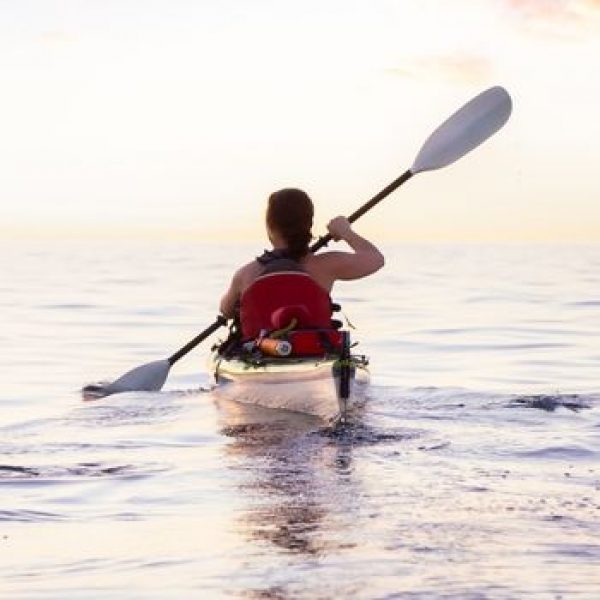How to Store a Kayak? The Ultimate Kayak Storage Guide
How to Store a Kayak? The Ultimate Kayak Storage Guide
Kayaks are a great way to explore the outdoors and enjoy some time on the water. But when you’re not using your kayak, it needs to be stored properly in order to keep it in good condition. Storing a kayak can help protect it from UV rays, extreme temperatures, and the general wear-and-tear that comes with outdoor use.
Fortunately, there are several different ways of storing a kayak so that you can find the best option for your particular situation.
Whether you have limited storage space or want an easy solution for transporting your boat, this guide will provide all the information needed to store a kayak safely and securely.
From indoor racks and slings to outdoor hoists and trailers, we’ll show you how to make sure your kayak is ready for its next adventure!
If your kayak is already worn out, check out our post on buying some of the best kayaks for under $1000.

Table of Contents
Indoor Storage - How to Store a Kayak?
If you’re lucky enough to have some extra space in your home or garage, then indoor storage is the best way to keep your kayak safe. There are several different types of racks and slings that are designed specifically for storing kayaks indoors.
Most of these options require minimal assembly and installation time, so you can quickly move your kayak in and out of storage as needed.
Storing your kayak in the garage can provide an ideal environment for your watercraft. The critical thing to consider is weight distribution and proper support to prevent sagging and warping over time.
To achieve this, use secure wall mounts or ceiling hoists to keep the kayak suspended off of the floor. Additionally, you want to keep it from sliding around if you don’t plan on permanently mounting it with padded straps.
If this isn’t an option, simply consider balancing two kayaks across two sawhorses for a simple and effective storing solution. Regardless of shop space, a garage should always be well-suited for safely stowing away your kayak.
Storing a kayak in an apartment isn’t always easy due to limited space, but with a bit of creative thinking, you can make it work!
Firstly, try to secure extra vertical space – hang the kayak by its’s main handles on cupboard doors or wall brackets. Secondly, investigate solutions that don’t need to be mounted, such as rolling storage carts and stackable racks.
If you’re lucky enough to own a balcony, consider installing hooks along the railings. Another option is to rent out temporary depot space. Short-term rental options are good when wanting a climate-controlled environment for your kayak and other equipment, which will ensure longevity and protection from the elements. Whatever your situation may be, there’s sure to be a suitable storage solution!
Outdoor Storage - How to Store a Kayak?
For those who don’t have the luxury of indoor space, outdoor storage could be the next best option for preserving your kayak. There are a variety of hoists and trailers that can be used to securely store your kayak outside.
Hoists are especially helpful in areas with high winds, as they can keep your kayak off the ground and securely stored away when not in use.
Storing your kayak outside can be a great way to free up much-needed space inside, but it is essential to be mindful of what elements can do the most damage. Choosing a dry, sheltered spot from wind and rain is going to be essential in helping keep your kayak safe from UV exposure and corrosion over time.
You should also look for an area that allows for good air circulation so that water doesn’t collect on the surface of the vessel.
If you are planning on leaving it outdoors for more than two days, you may want to consider investing in a quality kayak cover or tarp to offer additional protection from weather and wildlife.
Taking these steps will ensure your kayak stays looking and performing its best for years to come.
How to Store a Kayak Outside in Winter :
Storing your kayak outdoors in winter can be surprisingly simple when you take the right steps. Ensure that any cover you use is highly breathable and water-resistant, as this will help keep moisture away from the kayak. Where possible, try to store it on a flat or solid surface, such as concrete blocks or stones, rather than directly on the ground.
This will help avoid retaining moisture or creating pools of water underneath. If you have limited storage space, using the deck underside makes an ideal storage space for your kayak.
Remember to buy appropriate protection for your kayak with covers, UV protection, and waxing to make sure it remains in shipshape condition, whatever the weather throws at it.
With these considerations in mind, you can securely and confidently store your kayak outside all year round!
How to Store a Kayak Vertically :
Storing a kayak vertically is an excellent solution for minimizing space if you need to keep it indoors. When done correctly, this method is safe, easy, and affordable – the only things you’ll need are two separate mounts that can be affixed to the wall in your garage or storage unit.
To begin with, secure one mount close to the ceiling so that it’s firmly attached; using concrete screws is ideal as they will create a stronger bond. Next, attach the other mount about three feet lower in order to create a “hammock” of sorts so the kayak can fit snugly without sagging down too far.
Once this is done, you can easily slide your kayak from the top mount into position, and rest assured it won’t move around or tip over.
How to Safely Store Your Kayak :
Kayaks are a wonderful way to travel and explore the great outdoors. To ensure your kayak remains in good working order, it is essential to store your kayak safely.
When you’re not using your kayak, make sure you keep it off the ground by storing it on its hull or using small brackets or hooks on a wall. This will help protect the structural integrity of your kayak and prevent any long-term damage caused by water seepage.
If you must store your vessel outside, pick an area that has some protection from the elements, such as a roof, shed, or garage. An outdoor shelter is ideal but may require adequate weatherproofing to protect against direct sunlight and rain.
Finally, be sure to clean and dry your kayak after each use to rid of any moisture that could cause long-term damage if left unchecked over time.
Accessories That Can Help You Store Your Kayak More Easily and Securely :
If you own a kayak, you likely recognize the challenge of finding a suitable place to store it. Many places to store a kayak are challenging to access or take up too much space.
Fortunately, there are accessories that can help you store your kayak more easily and securely. Storing your kayak in a specialized rack is one way to organize it better in indoor or outdoor spaces.
A storage cover for the kayak can further protect it from weather damage, dust, and dirt and help prolong the lifespan of your craft. If you need more portability when transporting multiple kayaks, specialized trolleys can make traveling with them simpler.
The correct accessories can make storing and traveling with your kayak simpler and less frustrating, so feel free to explore what might work best for your needs!
How to Choose The Right Storage System For Your Kayak :
When it comes time to choose a storage system for your kayak, there are a few key factors to consider.
Firstly, you’ll want to define what kind of storage you’re seeking, whether something heavy-duty, like a mountable rack or wall hanger, or something with more flexibility, such as strapping your kayak to the roof of your car.
Secondly, ensure the system you choose is compatible with any existing infrastructure.
Finally, research to determine which system is ideal for the weight and size of your vessel. Knowing these factors in advance can help you make an informed decision when selecting storage for your kayak.
Tips For Keeping Your Kayak in Good Condition :
1. Make sure to choose a location with plenty of shade and away from direct sunlight when storing your kayak outdoors. Sunlight can cause premature fading and wear on the material of the kayak over time.
2. When using an indoor rack system, make sure all screws are securely tightened so that the kayak does not become loose or shift during transport.
3. If you are using a hoist system outdoors, make sure to check the pulleys frequently to ensure they are working properly.
4. Consider purchasing a trailer designed for kayaks if you plan on frequently transporting your boat from one destination to another.
5. Be sure to use protective covers or tarps when storing your kayak outdoors in order to protect it from the elements, such as rain, snow, and wind damage.
6. Always double-check that all straps and ropes are securely fastened before leaving the kayak unattended. This will help ensure that your kayak is safely stored, whether indoors or outdoors!
By following these simple tips and using the right storage solution, you can keep your kayak safe and secure until its next adventure.
Whether it’s a short trip down the river or a long voyage across the ocean, proper kayak storage is one of the keys to ensuring your boat’s longevity! Enjoy the great outdoors and explore with confidence knowing that your kayak is securely stored away when not in use.
No matter what type of storage you choose, it’s important to make sure your kayak is properly secured before leaving it unattended.
Storing a kayak is a great way to keep it in good condition and ensure that it’s always ready for your next adventure. With the right storage solution, you can rest easy knowing that your kayak is safe and secure!

Florence Any
My Self Florence Any. I’m an experienced kayaker and angler, with a passion for exploring the outdoors. I have been kayaking for over 10 years and fishing for over 15 years and combines both of my hobbies whenever I can. My own adventures on the water have taken me to some of the most remote and beautiful places in the world. I’m also an experienced writer, and my writing reflects her love for kayaking and fishing. I have written several articles, essays and even a book about the adventures I have on the water, and her work has been featured in various outdoor and kayaking magazines.

Pingback: How to Transport Kayak Without a Roof Rack? Best Tips